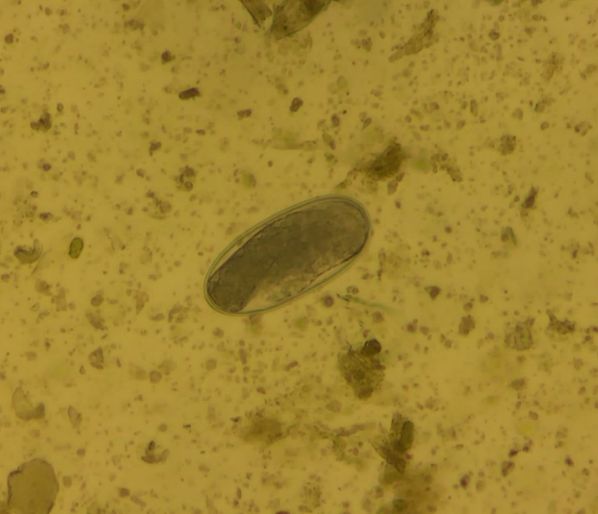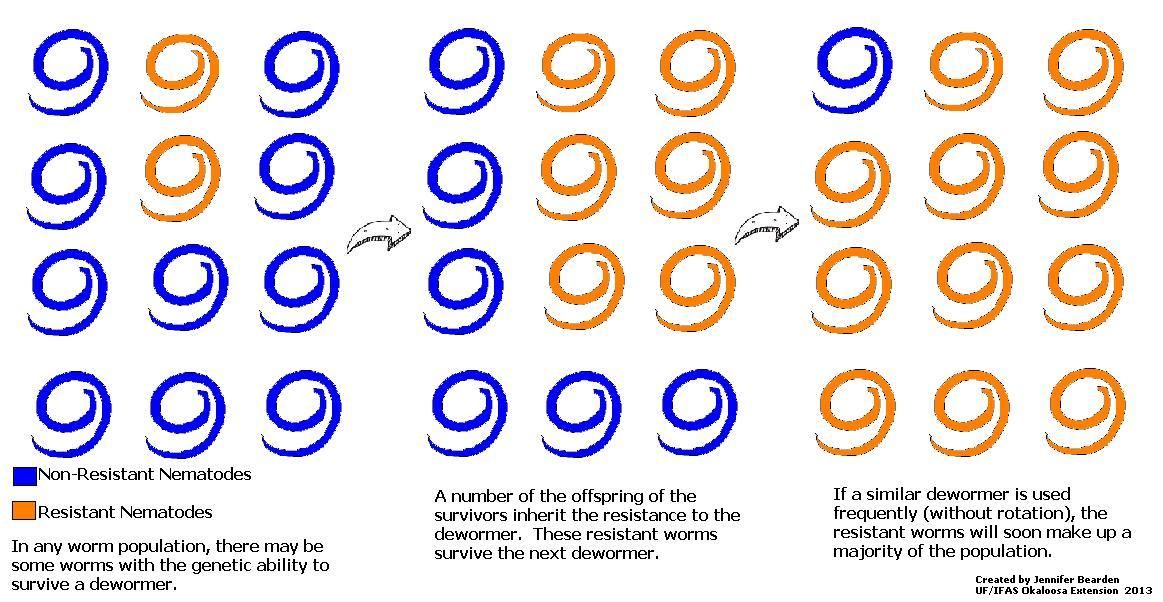Key Take-Home Points
- The American Association of Equine Practitioners (AAEP) Internal Parasite Guidelines recommend that adult horses (i.e., over 3 years of age) do not need to be routinely dewormed until the strongyle fecal egg count (FEC) is at least 200 to 500 EPG, with the caveat that all adult horses should be dewormed at least once each year with a compound containing a macrocyclic lactone (ivermectin or moxidectin) and praziquantel. This reduces over-treatment in low shedders, and still protects against large strongyles and tapeworms.
- During the first year of life, foals should receive a minimum of four anthelmintic treatments. First deworming should occur at about 2–3 months of age; a benzimidazole drug (fenbendazole) is recommended to ensure efficacy against ascarids. Second deworming is recommended just before weaning (approximately 4–6 months of age). Third and fourth treatments should be considered at about 9 months of age and 12 months of age, respectively, and treatment should primarily target strongyles (moxidectin or ivermectin).
- Twice each year, perform a McMaster FEC on all horses to determine the parasite load for each individual. Horses with a FEC greater than 500 EPG should receive an anthelmintic and a fecal egg count reduction test (FECRT) to evaluate resistance.
- Use an accurate body weight when administering anthelmintics. Underdosing leads to the development of resistant parasites. Body weight can be closely estimated using an equine weight tape.
- New adult horses added to the farm should be dewormed with moxidectin or ivermectin on arrival. Conducting FECs to determine parasite shedding status before introducing new horses into the existing herd or placing new horses on pastures is recommended.
- Environmental management has become a key component of parasite control on equine properties. It has the added benefits of reducing parasite populations without contributing to parasite resistance.
- For up-to-date recommendations on internal parasite control for adult horses and foals, consult the AAEP Internal Parasite Guidelines at www.aaep.org.
Introduction
Recommendations for deworming programs in horses have changed substantially in recent years. Due to the emergence of resistant parasites (worms that are no longer killed by deworming medications), much of the emphasis has shifted to targeted deworming (treating only certain horses) rather than traditional rotational treatment of all horses on a property. The American Association of Equine Practitioners (AAEP) recommends establishing a program with your veterinarian that works best for your horse or herd. Additionally, environmental management has become a key component of parasite control on equine properties and has the added benefits of reducing parasite populations without contributing to parasite resistance. This article will review the most common parasites in horses and provide horse owners with recommendations for parasite prevention.
Internal Parasites of Adult Horses and Foals
The most devastating internal parasites to the adult horse are small strongyles (cyathostomes) (Figure 1), large strongyles (bloodworms), and tapeworms. Ascarids (roundworms) are the most important parasite of foals in the first year of life. Resistance patterns differ between small strongyles and ascarids. Therefore, adult horses and foals cannot be effectively dewormed with the same products. Other equine parasites include bots, pinworms, stomach worms, lungworms, and threadworms. The life cycle of most parasites includes eggs, larvae, and adults. Parasite eggs are passed in manure and deposited onto the ground. The larvae develop in the eggs and hatch, allowing them to be ingested by the horse during grazing. The larvae mature into adults in the digestive tract of the horse, with some species migrating through the animal as developing larvae before completing the parasite life cycle. Most parasite larvae desiccate in the hot summer weather in Florida. Treatment in Florida should focus on control during the cooler seasons: fall, winter, and spring.

Credit: Jennifer Bearden, UF/IFAS
In the past, horse owners would deworm their horses every four to eight weeks to treat them for intestinal parasites, but this practice leads to resistance. Resistance occurs when parasites develop the ability to survive treatment with deworming medications that were previously effective. The more deworming medications are used, the faster resistance develops—and this resistance is not reversible once it occurs. Resistance is passed from one parasite generation to the next, creating more and more resistant parasites over time (Figure 2). To address this, modern deworming practices focus on only treating the horses that need it the most (i.e., young horses and those with heavy parasite burdens). This practice results in far less deworming than a traditional “rotating dewormer” program and slows the rate of resistance development by maintaining a population of nonresistant parasites in the horses that are not receiving treatment. This nonresistant, non-treated population of parasites is called “refugia,” and is pivotal to modern parasite control strategies. The refugia parasites shed eggs containing nonresistant genetic code into the environment and help dilute resistant parasites within the population over time.

Credit: Jennifer Bearden, UF/IFAS
Targeted Deworming Strategies to Prevent Resistance
A heavy burden of parasites can cause weight loss, a rough hair coat, poor performance, diarrhea, and colic. Deworming programs should aim to maintain the health of the horse(s), minimize costs, and prevent the development of resistant parasites. Before deworming your horse, your veterinarian or a trained professional should do a Modified McMaster Fecal Egg Count (FEC) on your horse's manure to see if your horse is a low, medium, or high shedder of parasite eggs. The fecal egg count test is done to identify horses that consistently carry higher loads of parasite eggs. These horses are more likely to develop clinical signs of parasitism (ill thrift, poor hair coat), and they also pass large numbers of infective eggs into the environment. An appropriate anthelmintic should be selected based on the age of the horse, the FEC, and the type of parasites detected or suspected to be present. About 2 weeks after deworming, your veterinarian may also do a fecal egg count reduction test (FECRT) using fecal samples collected before and after treatment to see if the deworming product was at least 90% effective. It is also important to treat for tapeworms once or twice a year with praziquantel.
While targeted deworming works well for adult horses, it should not be used for foals and horses under 12 months of age. Young horses are more susceptible to ascarids (roundworms), and heavy ascarid burdens can be fatal if left untreated (Figure 3). Widespread ascarid resistance to the macrocyclic lactones (ivermectin and moxidectin) has been documented. Thus, foals should be dewormed every 60 days with fenbendazole or pyrantel until they are 6 months old, at which time a fecal egg count should be performed to determine if the parasite burden is primarily ascarids (warranting treatment with fenbendazole or pyrantel) or small strongyles (warranting treatment with ivermectin or moxidectin).

Credit: Dana Zimmel
Equine tapeworms are difficult to identify in fecal examinations. Deworming all horses for tapeworms is recommended biannually or annually with a product containing praziquantel (Zimecterin Gold®, Equimax®, Quest Plus®).
How to Determine Drug Resistance on a Farm
The best way to determine anthelmintic resistance on a farm is to perform a fecal egg count reduction test. To perform this test, a McMaster FEC is conducted before deworming to determine baseline egg counts. The horse receives an anthelmintic and the McMaster FEC is repeated 10–21 days later, depending on the anthelmintic administered. If a benzimidazole or pyrantel was administered, a fecal egg count reduction of less than 80% is indicative of resistant parasites. If a macrocyclic lactone (ivermectin or moxidectin) was administered, a fecal egg count reduction of less than 98% is considered resistant.
Environmental Management
Environmental practices aim to minimize parasite burdens by reducing the number of parasites in the horse’s environment. These practices have the added benefit of reducing parasite levels without contributing to the development of resistance. Recommendations for controlling parasites on horse farms include the following.
- Prevent overgrazing and reduce fecal contamination by keeping the number of horses per acre to a minimum.
- Group horses in a pasture by age to reduce exposure to certain parasites and maximize the deworming program geared to that group. Perform FECs in horses new to the farm to determine shedding status/parasite burden prior to cohabitation with resident horses.
- Clean and dispose of manure in the pasture at least twice every week.
- Mow and harrow pastures regularly to break up manure and expose parasite eggs to the sun. Make sure to remove horses from a harrowed pasture for 2 to 4 weeks.
- Do not spread fresh manure on pastures.
- If possible, rotate pastures by allowing other livestock to graze them.
Reference
American Association of Equine Practitioners. 2022. “American Association of Equine Practitioners.” https://www.aaep.org